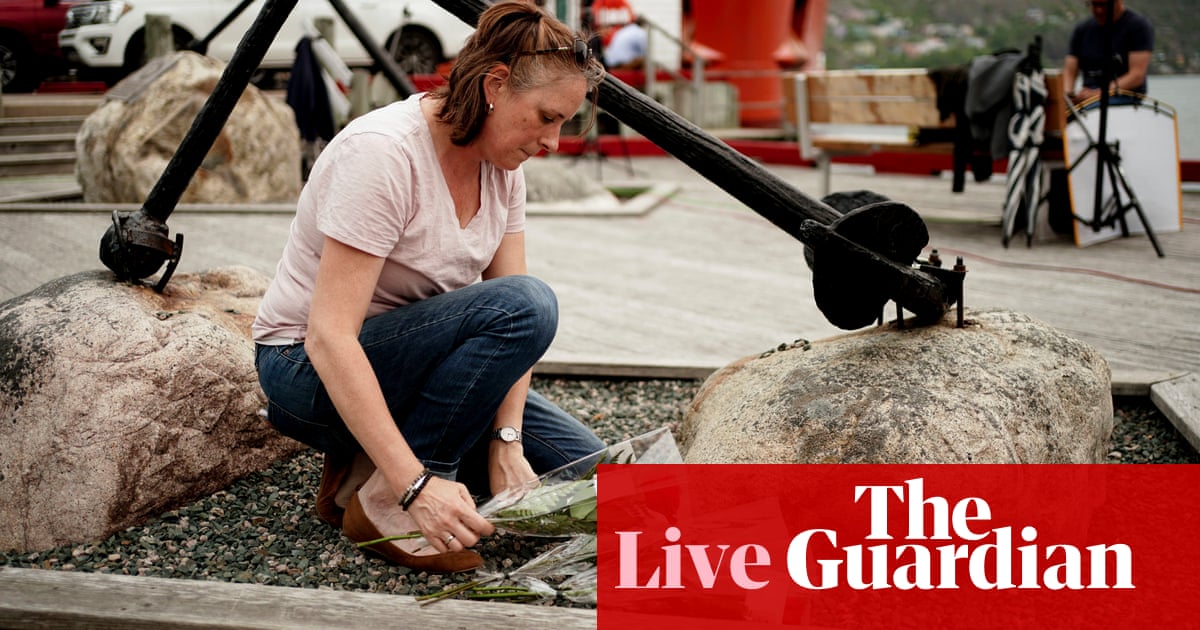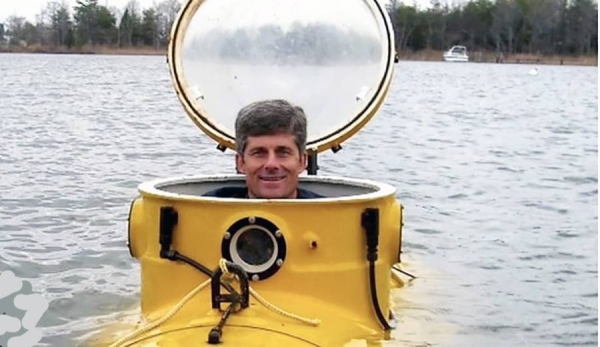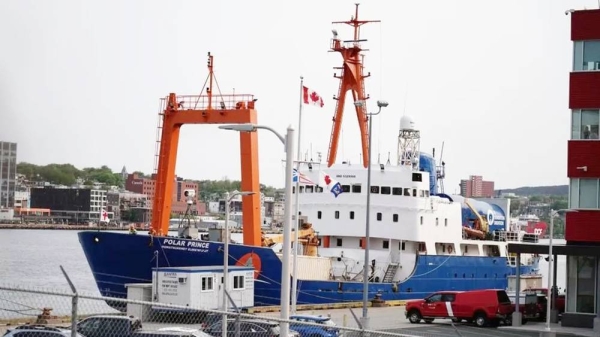
Canada launches investigation into Titan tragedy
The Transportation Safety Board of Canada (TSB) has announced that it is launching an investigation into the loss of the Titan sub.
A team of investigators is now travelling to St John’s, Newfoundland, to “gather information, conduct interviews, and assess the occurrence”, it said.
In a statement, the board said it was launching “a safety investigation regarding the circumstances of this operation” because the Titan’s surface support vessel, the Polar Prince, was a Canadian-flagged ship.
In accordance with the Canadian Transportation Accident Investigation and Safety Board Act and international agreements, the TSB, as the investigation authority of the flag state of the support vessel involved in the occurrence, will conduct a safety investigation regarding the circumstances of this operation conducted by the Canadian-flagged vessel Polar Prince.
Summary of the day"s Titan submersible tragedy updates
Here are some of the day’s highlights:
The aunt of the 19-year-old killed aboard the Titan said the young man was gravely afraid of going on the exploration. But he did so to please his father.
Online commenters and journalists are calling out Stockton Rush, the CEO and co-founder of OceanGate who was killed onboard the Titan submersible, for his goals of using his deep sea exploration tourism as a cost-effective tool for oil and gas companies.
The Transportation Safety Board of Canada (TSB) has announced that it is launching an investigation into the loss of the Titan sub. A team of investigators is now traveling to St John’s, Newfoundland, to “gather information, conduct interviews, and assess the occurrence”, it said.
UK and US officials picked up a “large acoustic signal” indicating an implosion of the Titan sub days ago, but did not release the information to the public or some members of the rescue teams because it was classified, according to a UK naval source.
OceanGate, the company behind the Titan submersible, exaggerated details of the industry partnerships behind the development and engineering of its sub. Boeing and the University of Washington have denied the company’s claim that they helped design the sub.
Online commenters and journalists are calling out Stockton Rush, the CEO and co-founder of OceanGate who was killed onboard the Titan submersible, for his goals of using his deep sea exploration tourism as a cost-effective tool for oil and gas companies.
His father, Richard Stockton Rush Jr, is the chairman of Peregrine oil and gas company based in northern California. In addition to his familial ties to the industry, Stockton Rush sought to sell his submersibles as a tool for companies who want to explore deep sea drilling opportunities but aren’t willing to pay for the machinery that would support that field research.
In a 2017 Fast Company article, Rush said that OceanGate wouldn’t be involved in oil production, but instead were, “just going to be involved in inspection, repair, and maintenance”.
Click here to read the Fast Company piece in it entirety.
Suleman Dawood, the 19-year-old who was killed on the Titan was reportedly incredibly scared to take the deep sea trip and “wasn’t very up for it”, Azmeh Dawood, the teen’s fraternal aunt told NBC News. But he took the expedition – which was during Father’s Day weekend – to please his father.
“I feel disbelief. It’s an unreal situation … I feel like I’ve been caught in a really bad film, with a countdown, but you didn’t know what you’re counting down to,” Dawood told NBC.
Greetings, I’m Abené Clayton taking over the Guardian’s submersible tragedy blog from the west coast. Stay tuned here as more information on what went wrong emerges.
Summary of the day so far
Here’s a recap of the latest developments:
A day after revelations that the Titan submersible imploded, officials are searching the ocean floor for evidence and determining who will be responsible for investigating the international disaster. The US Coast Guard said a formal inquiry has not yet been launched because maritime agencies are still busy searching the area where the vessel fell apart.
The Transportation Safety Board of Canada (TSB) has announced that it is launching an investigation into the loss of the Titan sub. A team of investigators is now travelling to St John’s, Newfoundland, to “gather information, conduct interviews, and assess the occurrence”, it said.
A new mission to the submersible debris field near the wreckage of the Titanic is under way, according to the company behind the remotely operated vehicle (ROV) that first discovered the debris site.
UK and US officials picked up a “large acoustic signal” indicating an implosion of the Titan sub days ago, but did not release the information to the public or some members of the rescue teams because it was classified, according to a UK naval source.
The search for the missing Titan submersible is expected to cost the US Coast Guard millions of dollars. OceanGate, the company that built and ran the vessel, will probably not be required to reimburse the US government for the search operation.
OceanGate, the company behind the Titan submersible, exaggerated details of the industry partnerships behind the development and engineering of its sub. Boeing and the University of Washington have denied the company’s claim that they helped design the sub.
Stockton Rush, the CEO of OceanGate who was killed onboard the Titan submersible, repeatedly dismissed warnings over the safety of the sub, emails between Rush and a deep sea exploration expert show.
Titanic film director and deep-sea exploration veteran James Cameron has said the Titan submersible tragedy was “only a matter of time” after Oceangate was warned the sub could “lead to literally catastrophic failure”.
An American investor has said he was offered cut-price tickets on the Titan’s doomed trip to the Titanic wreck and was told by OceanGate CEO, Stockton Rush, that the journey would be “safer than crossing the street”.
UK and US officials picked up a “large acoustic signal” indicating an implosion of the Titan sub days ago, but did not release the information to the public or some members of the rescue teams because it was classified, according to a report.
The implosion was picked up by a “classified military device” in the North Atlantic and assessed by officials from the UK and US shortly after communication was lost with the Titan vessel, a UK naval source told the i.
The source said:
Whilst it would appear that classified systems may have heard noises detailing an implosion… as with all searches, you have to remain optimistic until you can categorically declare to the contrary.
The UK’s foreign office had been in regular contact with the victims’ families, who “might have been told different” to what was made public, the source said.
The search for the missing Titan submersible is expected to cost the US Coast Guard millions of dollars.
OceanGate, the company that built and ran the vessel, will probably not be required to reimburse the US government for search operation.
Paul Zukunft, a former US Coast Guard commander, told the Washington Post:
It’s no different than if a private citizen goes out and his boat sinks. We go out and recover him. We don’t stick them with the bill after the fact.
Canada launches investigation into Titan tragedy
The Transportation Safety Board of Canada (TSB) has announced that it is launching an investigation into the loss of the Titan sub.
A team of investigators is now travelling to St John’s, Newfoundland, to “gather information, conduct interviews, and assess the occurrence”, it said.
In a statement, the board said it was launching “a safety investigation regarding the circumstances of this operation” because the Titan’s surface support vessel, the Polar Prince, was a Canadian-flagged ship.
In accordance with the Canadian Transportation Accident Investigation and Safety Board Act and international agreements, the TSB, as the investigation authority of the flag state of the support vessel involved in the occurrence, will conduct a safety investigation regarding the circumstances of this operation conducted by the Canadian-flagged vessel Polar Prince.
A day after revelations that the Titan submersible imploded, officials are searching the ocean floor for evidence and determining who will be responsible for investigating the international disaster.
The US Coast Guard said on Friday that a formal inquiry has not yet been launched because maritime agencies are still busy searching the area where the vessel fell apart.
Debris was located about 12,500 feet (3,810 meters) underwater in the North Atlantic, not far from the Titanic wreckage it was on its way to explore. The US Coast Guard led the initial search and rescue mission.
On Thursday, R Adm John Mauger said: “I know there are also a lot of questions about how, why and when did this happen. Those are questions we will collect as much information as we can about now.”
According to AP, it is unclear who would have the authority to lead what is sure to be a complex investigation involving several countries.
OceanGate Expeditions, the company that owned and operated the Titan, is based in the US but the submersible was registered in the Bahamas. OceanGate is based in Everett, Washington, but closed when the Titan was found.
Meanwhile, the Titan’s mother ship, the Polar Prince, was from Canada, and the people on board the submersible were from England, Pakistan, France, and the U.S.
New mission to debris site underway, says ROV company
A new mission to the submersible debris field near the wreckage of the Titanic is under way, according to the company behind the remotely operated vehicle (ROV) that first discovered the debris site.
A spokesperson for Pelagic Research Services told CNN that the mission of the Odysseus 6 ROV is to continue searching and mapping out the debris sites.
The ROV’s mission – its second since discovering the debris site yesterday – began earlier today and will take about an hour to reach the location of the debris field, CNN reported.
The spokesperson, Jeff Mahoney, added that any attempts to recover anything from the site would be a larger operation, because the debris will likely be too heavy for the ROV to lift by itself.
The company expects to be on site conducting ROV missions for another week, he said.
A former employee of OceanGate who said he was fired after he raised safety concerns about the Titan vessel said he was “profoundly saddened to learn of the loss of the Titan and its crew”.
David Lochridge, OceanGate’s former director of marine operations, questioned the ability of the sub’s hull design to withstand such depths in a 2018 lawsuit.
In a statement to the BBC, Lochridge declined to comment on OceanGate or the 2018 lawsuit, but said:
My deepest condolences go out to the families of those who perished in this tragedy. I cannot imagine your pain at this time.
I also extend my gratitude to the rescue services, military personnel, and everyone else involved who worked relentlessly under challenging conditions to bring the Titan crew home.
Their tireless efforts underscore the critical network in place to support our subsea community.
US transport safety watchdog to try to find potential cause of sub implosion
The US Coast Guard has asked the US National Transportation Safety Board (NTSB) to assist in the investigation into the Titan’s implosion, NBC News is reporting, citing a source.
The NTSB’s office of Marine Safety, in conjunction with the Coast Guard, will attempt to find the potential cause of the deep-sea catastrophe, the source said.












